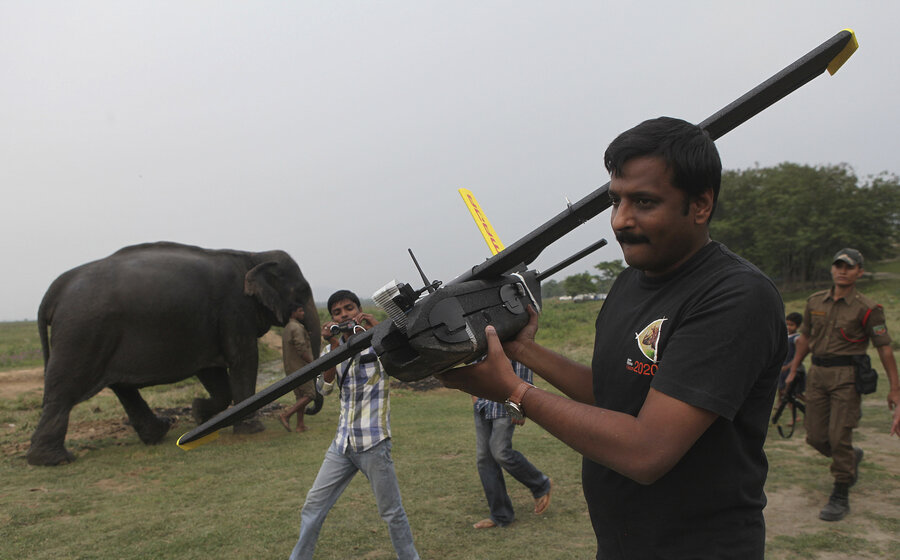Can drones be used to protect wildlife?
Loading...
Unmanned aerial vehicles (UAVs), or drones, can help protect wildlife – but they can make animals dangerously stressed out, finds a study published Monday.
Two researchers from The University of Adelaide's Unmanned Research Aircraft Facility (URAF), PhD candidate Jarrod Hodgson and professor Lian Pin Koh, published a report in the Cell Press journal Current Biology that suggests a set of best practices for researchers to follow when employing drones around wildlife.
"Considering the growing popularity of UAVs as a tool among field biologists, we advocate for the precautionary principle to manage these risks," write the authors in their article, which is expected to be published Monday. "Specifically, we provide a suite of recommendations as the basis for a code of best practice in the use of UAVs in the vicinity of animals or for the purpose of animal research, which supplement current standards in animal field research and reporting."
Along with adopting the precautionary principle, Mr. Koh and Mr. Hodgson suggest adhering to civil aviation rules, which can include restrictions on flying above a certain altitude, at night or within a certain proximity to people and infrastructure. UAVs should also minimize visual and audio output as much as possible.
It may even be beneficial, suggest Koh and Hodgson, to design the shape and color of UAVs with the relevant environment in mind. UAVs can be modified "to mimic non-threatening wildlife" native to the area, such as a local, non-predatory bird.
"We encourage authors to be proactive in sharing suggestions for improving UAV best practices in biological field research and also to guide the regulation of recreational use," write the authors. "Promoting the awareness, development and uptake of a code of best practice in the use of UAVs will improve their suitability as a low impact ecological survey tool."
But this is not the first time researchers have warned of implications from UAVs.
Last year a team of researchers from the University of Minnesota tracked the stress levels of bears through heart rate monitors to analyze potential implications from nearby drones. And while their study was small in scope, they say the results are clear: Bears' heart rate rises when drones are nearby. One individual, for example, increased his heart rate from 40 beats per minute to 160.
"I would never advocate for stopping further use of drones [in wildlife research]," Mark Ditmer, lead author of last year's bear study, tells The Christian Science Monitor. "But maybe we use some caution until we have a better understanding of the best practices."
And while increased heart rates are not in themselves dangerous, adds Dr. Ditmer, drone-induced stress may cause important "behavior changes" such as running away into dangerous territory. Also, animals may become accustomed to the sound of drones and ignore future human sounds that do warrant a fight or flight response.
Several animals – including two birds, a kangaroo and a chimpanzee – have even taken their drone-induced stress out on the machines themselves, attacking them mid-flight.
However, with the wary precautions come other examples of UAVs' potential in wildlife conservation.
Last year the US National Oceanic and Atmospheric Administration (NOAA) began employing unmanned aerial vehicles to study whales. By hovering 100 to 150 feet above a whale pod, scientists can track the health of individual whales and the population numbers at large.
"We can't put a gray whale on a scale," said John Durban, a marine mammal biologist with NOAA, "but we can use aerial images to analyze their body condition – basically, how fat or skinny they are."
And through Air Shepherd, a Minnesota-based nonprofit, drones are fighting back against poachers in Africa. Patrolling for poachers can be a dangerous job that carries the potential for park rangers to be shot or expensive equipment to be destroyed. But drones can offer a safer, yet equally successful, solution.
"The silent, unmanned aircraft can be launched and flown constantly during high-probability poaching hours – often overnight when patrols by humans would be dangerous – and in areas prone to poaching activity," writes David Karas for the Monitor last year. "Infrared cameras and GPS technology in each drone relay data back to a mobile command post. When a potential poacher is spotted, the precise location can be relayed to park rangers, who can respond, investigate, and, if needed, apprehend poachers before any animals are killed."
Air Shepherd's drone patrols have a 93-percent accuracy rate in predicting poaching activity. In an area that previously witnessed 19 rhino killings each month, there have been zero deaths for six months while drones were deployed overhead.
Koh and Hodgson are optimistic that UAVs can be used safely and conscientiously around wildlife, the potential implications just have to be communicated.
"In our experience, the vast majority of UAV users, both biologists and hobbyists, do not want to disturb wildlife and will often seek advice from experts," says Hodgson in a press release.
"However, in some cases, users may be unaware that their UAV operations could be causing considerable and unnecessary disturbance. By promoting an awareness of the potential for UAVs to impact wildlife, we hope that users will be more conscious of the potential impacts and utilize the code to ensure their UAV operations are responsible."








